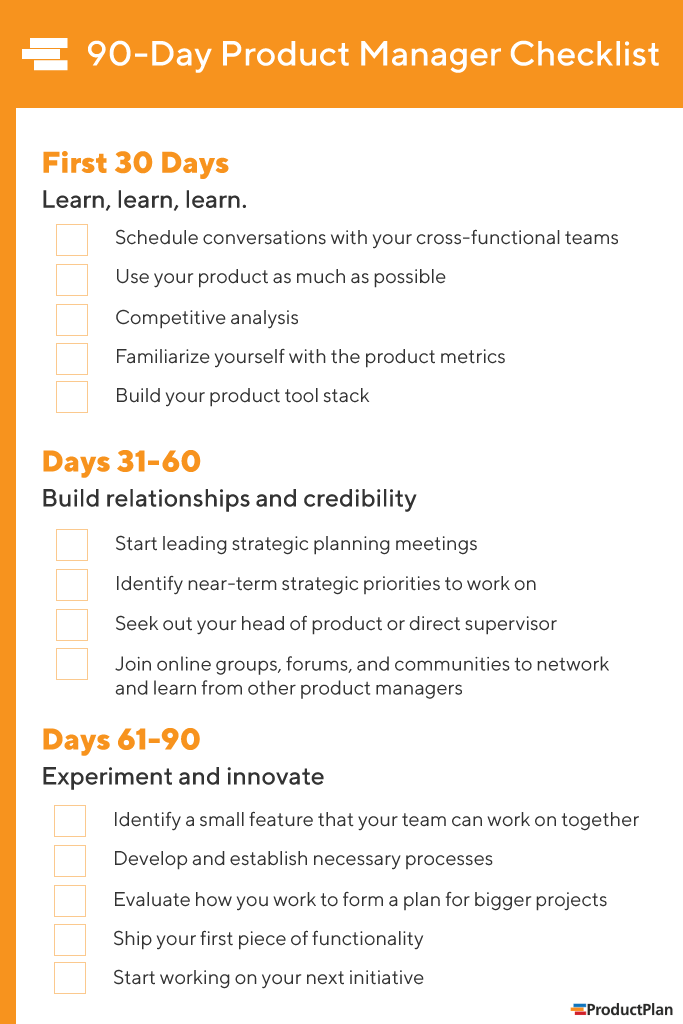When you start a new product management position, you can’t afford to “ease in slowly.” In your first days in the role, your coworkers won’t expect you to come up with a new product strategy or lead roadmap presentations to the executive staff. But you will face those responsibilities, and many others, soon enough. So it would help if you had a strategic plan from day one to learn as much as possible, build credibility with your team, and get ready to make real contributions. Therefore, every product manager should have the first 90 days on the job planned out.
What Should Every Product Manager Do in Their First 90 Days?
But what should that plan look like? How should you balance your time? Should you focus more on learning the technical and logistical details of how your company builds products, or on your market and customer personas?
To help you make the best use of these all-important early days of your new role, we’ve developed the following guideline for new product managers.
Note: You will notice overlap among the priorities we’ve outlined in the various stages below. That is intentional and strategic. For example, in your first weeks, you will ask a lot of basic questions that will help speed your learning. But in the second stage of your ramp-up period—the 30-to-60-day timeframe—you will still be asking questions. Here, though, the questions you ask will be more detailed and nuanced, as you become more familiar with your market and products. Also, asking intelligent questions at this stage can help you build relationships with your team.
90-Day Plan Template for New Product Managers
Your first 30 days: learn, learn, learn.
During your first month, your goal is to gain knowledge and understanding in the most important strategic areas of your job. This process means learning about your market, your users, your product’s competitors, your team’s skills and limitations, and your company’s culture.
How to do it:
As soon as you can schedule them, start having conversations with the right people. Including:
- Other product managers
- Developers
- Sales reps
- Marketing team
- Customer success team
- And of course, your users and customers
You can use customer interviews both to gather valuable feedback and to learn who your users are and why and how they use your products.
During your first month, you should also spend time using the product(s) you’ll be overseeing (this should be obvious). But you might be surprised at how many PMs say, “But we sell data analytics software, and I’m not a data analyst.” You need to learn your product from top to bottom from a user-experience standpoint. If you don’t, how can you expect to improve it?
You will also want to use these early days to study up on your market. Learn what you can about your competitors’ products, including what users say about them.
Additionally, in your first 30 days, you should get familiar with the product management tools that your team uses to get its work done. From roadmapping software to collaboration apps, you will soon be using these tools regularly. Now is the time to get comfortable with them.
Finally, you’ll want to learn which product metrics your company has been using to gauge success, and how the product has performed according to those metrics.
Want more guidance? Read this advice from our director of product management:
What every product manager should do in their 30 days at a new company
Days 31-60: build relationships and credibility
If you spent a large portion of your first 30 days meeting with members of your cross-functional team, that’s great. You have already begun developing relationships with the people whose help you will need to drive successful products.
In this next phase of your new job, you will want to start building on those relationships and developing your credibility as a product manager.
How to do it:
During your first 30 days, you spent more time listening than talking. Now is the time to start taking action, demonstrating what you’ve learned, and showing leadership.
For example, if you’re part of an agile development organization, you can run your team’s next sprint planning session. You might not have all of the strategic answers yet. But you can show your team you’re getting up to speed and that you can help keep their progress on track.
It’s also a good idea to proactively seek out your company’s head of product or your direct supervisor. They can help you identify near-term strategic priorities for you to start working on.
Caution: During the transition from listening and learning the first 30 days to this next stage, where they need to start performing, product managers often begin to feel that they don’t know what they’re doing. If you experience this, read our co-founder’s article:
How to overcome imposter syndrome as a product manager
You can also enhance your expertise and credibility by tapping into the vast amount of knowledge and generosity out there from other product managers. Join online groups, product management forums, and other communities dedicated to improving the shared wisdom among the PM community. To help you get started, we’ve prepared this list of helpful resources:
11 online communities product managers should join
Days 61-90: experiment and innovate
At this phase, you should be continuing to do many of the things you started in your first and second month on the new job—including researching your market, becoming familiar with your products, their success metrics, and having productive conversations with stakeholders.
But now it’s also time to do some real work on your product.

How to do it:
Your first steps in making strategic decisions about your product should be small. You want to find the right processes for working with your team and be sure everyone is communicating clearly—before trying to make any significant strategic moves.
Get together with your team and identify a small new feature, or enhancement, that you can work on together from start to finish, but that won’t upend the existing product.
Once you’ve determined what this small initiative will be, you can develop all of the processes you’ll be using on much bigger projects later. You can establish a cadence for sprint meetings, for example, and the most effective way to update and share priorities on your roadmap.
This exercise will also allow you to watch your new team in action, and learn everyone’s communication styles and preferred processes for working.
And the best part is, when you, the product manager’s, first 90 days are done, you’ll have shipped a real piece of functionality for your product. Congratulations. You’ve cleared the first major hurdle of any PM in a new job: working with a cross-functional team to release something to the market.
Now you’re ready for your next initiative. Welcome to your new team!
Learn more best practices for your product management career. 

![[Free report] 2021 State of Product Management ➜](https://no-cache.hubspot.com/cta/default/3434168/35d36a84-b157-43a1-acb7-b972dcb1d1ad.png)


